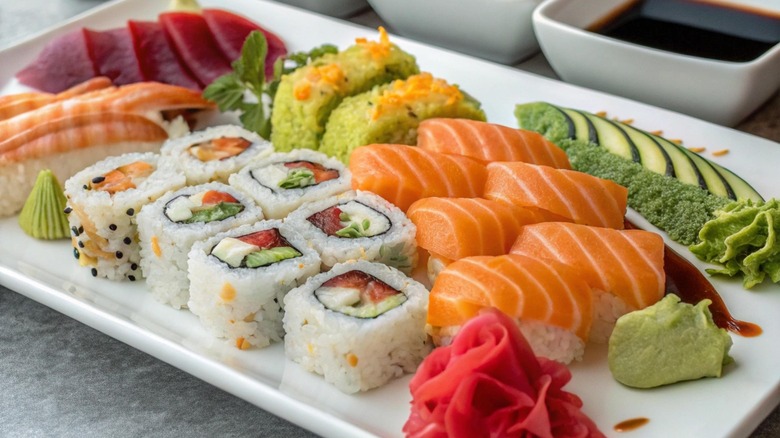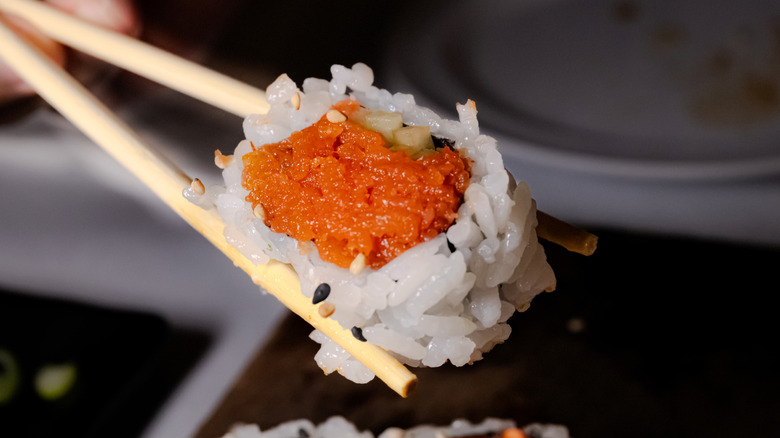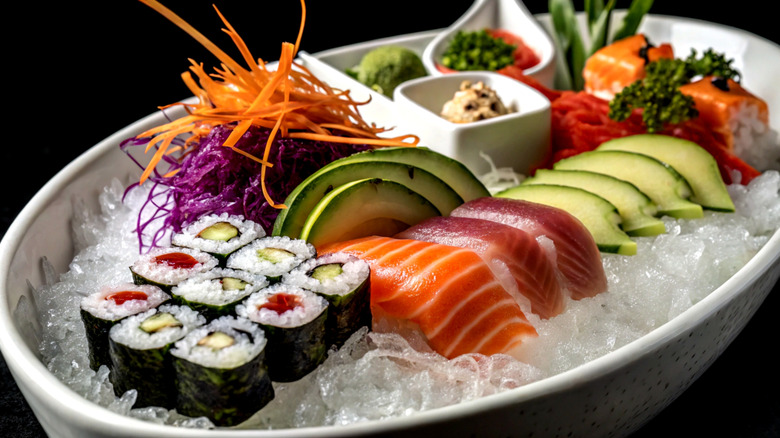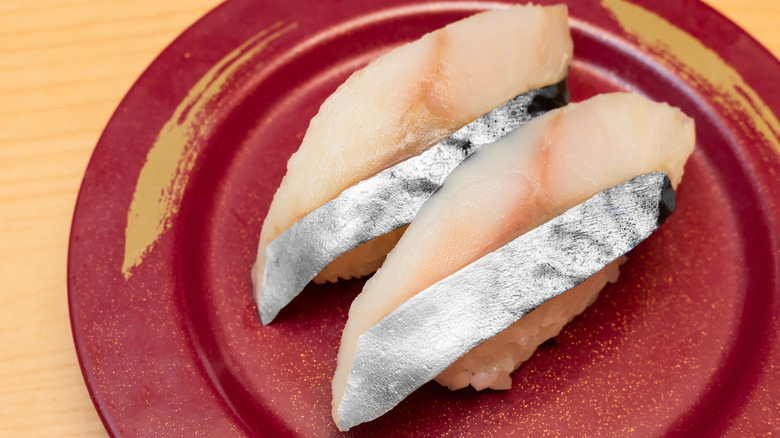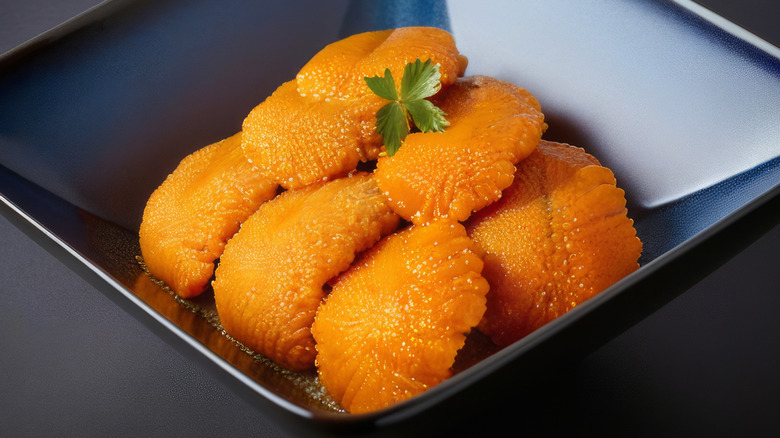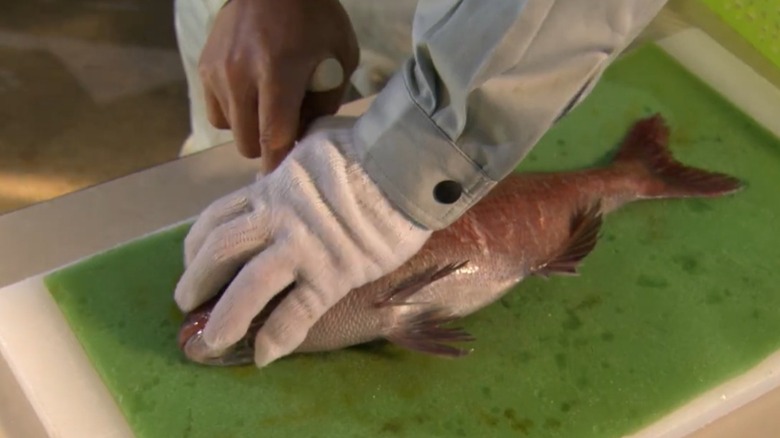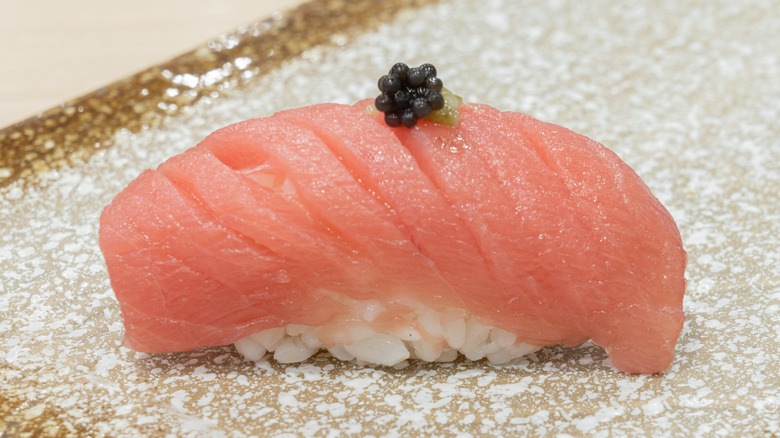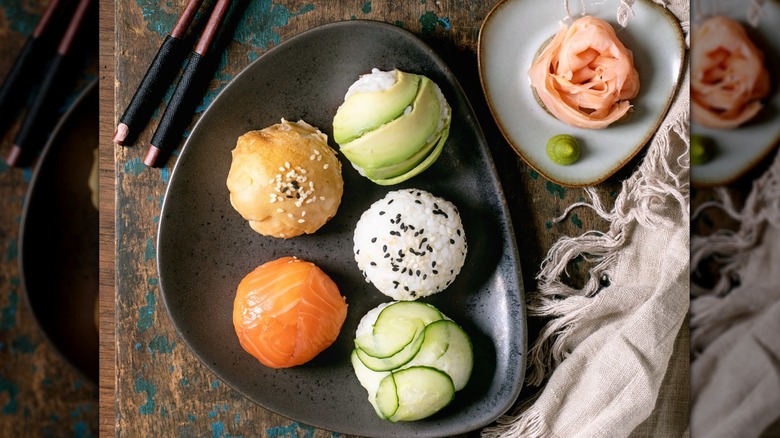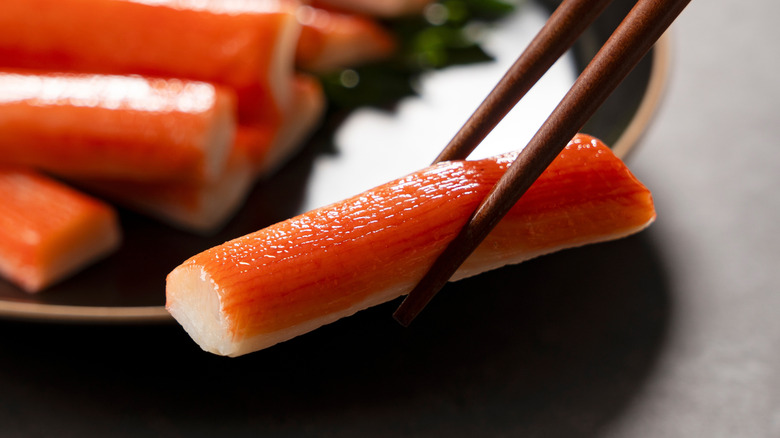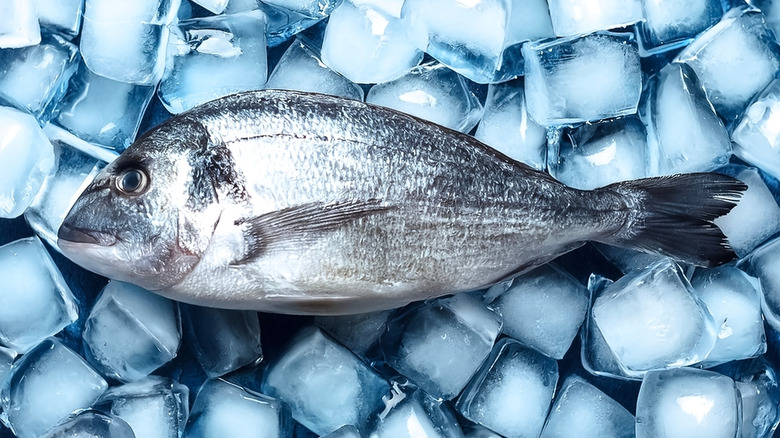13 Menu Items You Should Skip At A Sushi Restaurant
Long before the Chinese, Egyptians or Romans used salt to preserve food, prehistoric folks in Southeast Asia covered their fish in rice and weighed it down with rocks. Over the centuries, they learned vinegar did just as good a job and in a fraction of the time. By the 19th century, sushi stalls were everywhere in Japan, but it took until the 1960s for the cuisine to reach the United States.
In 1963, food journalist Craig Claiborne wrote in The New York Times that "sushi may seem a trifle too 'far out' for many American palates." He would be amazed to see how much of a booming business it has become, from retail or deli sushi to high-end restaurants across the U.S. But has that success spoiled sushi?
In the race to grab a slice of the action, some outlets may not offer the best experience for diners. But what should we be looking out for? Ben Chan, executive chef of Sushi Aozora, Nikki Zheng, founder and chef of Sushi Akira, Morgan Adamson, sushi shokunin at Hōseki, and Joel Hammond, chef de cuisine at Uchi West Hollywood, helped us out with a number of different menu items you should considering skipping at a sushi restaurant.
Spicy tuna rolls
The Japanese principle of "mottainai," or keeping food waste to a minimum, likely prompted Seattle Maneki chef Jean Nakayama's invention of the spicy tuna roll during the 1980s. Whatever his motivation, millions of American sushi lovers are forever grateful, and can't get enough of the combination of tuna scraps, mayonnaise, and sriracha, all bundled up in white rice. Sadly, not all tuna rolls are what they seem.
Rather than using tuna scraps — leftover cuts of quality but misshapen fish that can't be used for other dishes — some outlets use what's called "tuna scrape." This mass-produced blend of minced fish, containing artificial colors and preservatives, is often labeled as tuna but is a poor cousin to the real thing. Nikki Zheng said she gives tuna rolls a wide berth at generic sushi bars, adding they "reveal poor fish handling through dull color and flavor."
If it's his first visit to a sushi restaurant, Ben Chan does the same. He said the mix of minced fish with sauce in spicy tuna rolls made it difficult to judge freshness and quality. "For me, sushi is about the natural texture and clean flavor of the seafood," Chan said. "Once that's masked by heavy sauce, you lose the essence of sushi."
Sushi served at the wrong temperature
Many of us have had to send a plate of food back to the kitchen because it's cold and shouldn't be, but chances are fewer have done the same for a cold dish served warm. When eating at sushi restaurants, temperature is a dealbreaker for Nikki Zheng. "Sushi should have body-warm rice and slightly cool fish. If it's cold all around, it signals poor craftsmanship," she warned.
The chef highlights an important point and one that newcomers to Japanese food may know: Restaurant sushi shouldn't always be chilled. Some are obviously warm because they have been cooked, such as anything in tempura batter, dishes like flame-seared eel or sushi that is topped with cooked ingredients. Others, like nigiri (raw fish laid on vinegared rice) or fresh sashimi, which is a little different than sushi, are best served chilled.
For most fresh sushi, the guideline is to serve it at room temperature so it maximizes the flavor of the ingredients. If it tastes too cold, it could be because it contains lower-quality frozen fish. The rice should be at ambient temperature too, as it needs to be cool enough for the chefs to handle it, though during peak times there may not be enough time so it could be a little warmer.
Cured fish
Every restaurant stands or falls by the quality of its ingredients, whether it's fast food or fine dining. According to two of our experts, silver-skinned fish such as mackerel, kohada, and saba, known collectively as hikarimono, are a good way to assess whether a sushi eatery is worth visiting or not. These delicate fish are cured — "cooked" in rice wine vinegar (but probably not any of these substitutes) and salt — but Morgan Adamson would be unlikely to order them from a standard sushi restaurant, "because the process requires a lot of skill and attention."
Joel Hammond admitted he judges a sushi restaurant's quality by the cured fish on offer, and for him it's all down to the taste. "Fish like mackerel have a very short shelf life before they develop a strong fishy flavor." Ironically, hikarimono can also be smelly, but the odor should be of the sea, rather than anything else.
Achieving the delicate flavor balance of hikarimono depends on precise curing and timing, making them a tricky fish to get right. Rather than opting for a sun-of-the-mill sushi place, the better option is to find an omakase restaurant where the chef is trusted to select what customers are going to eat andthe level of skill — and food quality — is often higher.
Unsustainable fish
Overfishing has long been a global problem, with more than 33% of the 2,570 species monitored by the United Nations' Food and Agriculture Organization unable to replenish themselves naturally. Demand for sushi, which exploded worldwide during the pandemic, including in the United States, has placed even more pressure on the industry to be sustainable.
Although many people and organizations are working on solutions to increase wild fish stocks, chef Joel Hammond said he would avoid ordering highly unsustainable fish at a sushi restaurant "at all costs." Not everyone can get to outlets like Rosella in New York, which only serves fish approved by Seafood Watch or NOAA, but there are ways to ensure the sushi we're eating is sustainable.
Check whether your local outlet carries Marine Stewardship Council and Aquaculture Stewardship Council certifications. If it does, then the fish on the menu is more likely to have been responsibly sourced. Diners can also avoid eating potentially unsustainable fish by changing what they order, using Seafood Watch's simple guide to make an informed decision. If your preferred sushi is in the green list, it's good to eat. If it's red, you should skip it.
Oversized menus or special offers
The phrase "less is more" can apply to so many areas of life, but for our experts, one of them is a sushi restaurant's menu. While some consumers prefer having lots of choice, especially if they're bringing the kids along, not everyone finds a sprawling sushi restaurant menu appealing.
It would definitely sound alarm bells for Nikki Zheng and Ben Chan, making them question the quality of the food on offer. Chan said a menu overloaded with options, such as too many cooked or fusion-style rolls, suggested the chef wasn't focused on sourcing or handling raw fish properly.
He advised diners to find a sushi restaurant offering less. "A concise menu with a few seasonal items usually reflects a stronger understanding of ingredients," Chan explained. But it's not just a super-sized menu that we should sidestep, according to Morgan Adamson. She said her biggest red flag would be giveaways like "buy one get one." On the face of it, they may look great, especially if you're on a budget, but it's another hint that the sushi on sale might not be the best quality.
Poor quality uni
There are lots of delicacies on offer at sushi restaurants but one of the most divisive is uni, also known as sea urchin. Whether it's the sweeter murasaki uni or bitter, umami bafun uni, within one bite, people either love or loathe this seafood. It's been popular in the United States long before anyone from across the Atlantic set foot on these shores, especially among the Native Americans of the Pacific Northwest.
As with lots of sushi ingredients, the quality of uni varies from restaurant to restaurant. Ideally, fresh uni should have no odor, be a vivid yellow or gold color, have a creamy texture, and a slightly briny flavor. Older, or poorly handled uni won't have all these characteristics, which is why it's among the menu items Nikki Zheng would skip at a sushi restaurant. As far as she is concerned, there is no disguising low-quality seafood.
Morgan Adamson agreed, explaining that sushi chefs should be regularly tasting their uni to ensure it consistently met a high quality standard. "If the uni arrives bad (bad as in poor quality), it is just bad," she said. "There's no faking that or improving it with other ingredients."
Overcooked anago
Fresh ingredients and chefs who know how to handle them are the foundations of the sushi industry, yet not every restaurant can claim to have both. Anago sushi (also known as ni anago) is a good barometer of quality. Also known as saltwater eel, it shouldn't be confused with unagi, the freshwater counterpart. Anago sushi is eel that has been gently cooked in sugar, sake, and soy sauce, before being served on top of vinegared rice.
In the hands of an experienced chef, anago should be melt-in-the-mouth soft, with a robust, sweet flavor, but that's just one aspect of this delicious dish. Anago is also glazed with tsume, a concentrated sauce made from the broth the fish was cooked in, one that requires great technique to master.
For Ben Chan, anago ranks alongside uni as a dish he's willing to skip at a sushi restaurant to avoid being disappointed. The texture and flavor of saltwater eel can vary greatly depending on their freshness and temperature. "Handling them requires delicate timing and experience — even a few seconds off can change the entire bite," he said.
Acupuncture fish
Joel Hammond and Morgan Adamson had previously heard of acupuncture fish — though Adamson said she was curious enough to find out more. If half our experts were in the dark about it, a similar percentage of consumers could be too. Ben Chan and Nikki Zheng knew it as "ikejime," an advanced Japanese technique that effectively puts fish to sleep after they're caught.
Ikejime follows the same principles as traditional acupuncture, but not much else is known about the specifics, from the number of needles used to where they are placed on a fish, as it's a closely guarded secret. Some in the Japanese fishing industry suggest it improves the flavor of fish, a claim supported by Nikki Zheng and Ben Chan. They agreed ikejime can result in cleaner, firmer flesh, though both added the caveat: "When done properly." But how would the average consumer know if it was?
In 2014, Katy Perry posted on X, formerly known as Twitter about eating fish that "previously had acupuncture." Chef and celebrity endorsements aside, not everyone agrees with the practice, which severs the brain-spinal cord connection. These "zombie" fish are then transported to a restaurant, where chefs can showcase their freshness by filleting them alive.
Overpriced menu items
There's a world of difference between paying for a meal at a run-of-the-mill sushi outlet and a fancy omakase restaurant, as anyone who has eaten at Masa, one of the most expensive places to eat in the United States, will know. Although expertise and top-of-the-range ingredients justify a higher price, our experts made it clear we shouldn't be paying top dollar for everything.
Joel Hammond suggested giving overpriced salads or vegetable focused dishes a wide berth, as their prices were hiked so owners could offset the cost of fish. Nikki Zheng warned diners to steer clear of costly uni, and said it should be considered a premium item only at restaurants where it was "sourced and stored properly."
"The first thing that comes to mind for me is caviar," said Morgan Adamson, referring to the tiny amount of the topping on some nigiri, which shouldn't be confused with tobiko. "It always feels like it's a big up-charge," she added. Ben Chan's red flag was even more obvious: "Rolls with truffle oil, gold leaf, or excessive toppings often don't justify their prices." He said extras like this might seem fancy but they didn't enhance the sushi's flavor. "I'd rather pay more for seasonal fish that's genuinely rare and fresh," he said.
Trendy dishes that lack authenticity
Where does innovation begin and tradition end? When it comes to sushi, it's a good question, and one that has yet to be definitively answered as restaurants seek new and exciting ways to lure in diners. Morgan Adamson, who loves a spicy tuna roll now and then, said authenticity wasn't a requirement to enjoy sushi.
"I love the very traditional places that New York has to offer, but I also have an appreciation for fusion," Adamson said. "I think there is space for both." Joel Hammond said he was happy to give diners what they wanted, even if that meant serving up non-traditional sushi, like Philadelphia rolls, or incorporating other food trends. "If that's what makes it extra special to them, then it belongs on the menu," he enthused.
For Ben Chan, sushi restaurants that chased after trends were missing the point. "Sushi is about connection — between chef, season, and guest," he said. Chan added that the best sushi was "calm, deliberate, and natural," and anything rushed or showy should be avoided. Nikki Zheng felt the same. "Creativity is fine," she said, "but sushi should still honor its essence — balance, precision, and respect for ingredients."
Raw fish served on Mondays or nightly specials
There are lots of steps to follow when rustling up home-made sushi but starting with fresh, good quality ingredients is absolutely crucial — especially the fish. Once it has been cooked, the USDA recommends it is used within three or four days. After that, it should go into the trash, which brings us to a couple of controversial sushi restaurant menu items: Raw fish served on a Monday and nightly specials.
"The quality of all fish that you bring in is the most important," said Joel Hammond. He acknowledged it took a lot of expertise to create each sushi dish, and that would be a factor in their shelf life. But Hammond also insisted that, as a rule, restaurants working with high quality fish would look to sell it quickly, maximizing value as well as flavor.
Sushi eateries at the lower end of the market probably won't have the same focus on quality, and could serve older fish as part of a weeknight deal. Clues could be sushi that smells overly fishy or cheap salad bowls that have the day's leftovers tossed in. The best advice? If you don't have a regular sushi place, do some research on social media and find one that locals love.
Mislabeled or duped fish
There's a lot of talk about sushi and authenticity but it goes beyond whether cream cheese should be used in maki. One of the biggest issues with restaurant seafood is mislabeling, which can lead to customers paying over the odds for something that's been switched for cheaper, poorer quality fish. It has been going on for years but there are ways to avoid it, according to our experts.
Nikki Zheng urged diners to ask questions at their chosen restaurant. "A skilled sushi chef knows every fish's origin, handling, and seasonality," she insisted. Ben Chan said that restaurants that were transparent about where their fish came from were more likely to be trustworthy. His tip when it came to ordering slices of scarlet tuna was to check it was shiny and firm, adding that "fake substitutes look dull or watery."
Maki sold as crab rolls that had pictures of imitation crab were a bugbear for Joel Hammond. "If they aren't honest about using imitation crab, what else are they not being honest about?" he noted, before encouraging consumers to find out more about their favorite fish, so they know what to look for. Morgan Adamson offered a different view on mislabeled sushi. "There are no '100 percents' when you're dining out. Getting it right really matters to me, but mistakes every once in a while are unavoidable."
Badly thawed-out frozen fish
Most people who enjoy sushi understand that some, if not all, of the fish used in the dishes have been flash frozen, especially in middle or lower-end eateries. For nigiri or maki that use salmon or tuna, it's a necessity as freezing destroys parasites lurking in the fish that aren't good for humans.
Although omakase and very high end restaurants use a minimum of frozen fish, according to Joel Hammond, how it is thawed out has a huge role to play in quality. He said fish with a high fat content cope best with the freezing process. However, it also extracts moisture and, for many different types, the ice crystals that form in the flesh can destroy the texture.
Frozen fish that is used for sushi responds better to slow thawing, and definitely shouldn't be done this way. If defrosting happens too fast or the fish is badly handled, not only can the texture suffer but it can also dull the flavor, Nikki Zheng warned. The sushi on menus from restaurants that thaw their fish right will look and taste minimally different to those made with fresh fish, according to Ben Chan.
